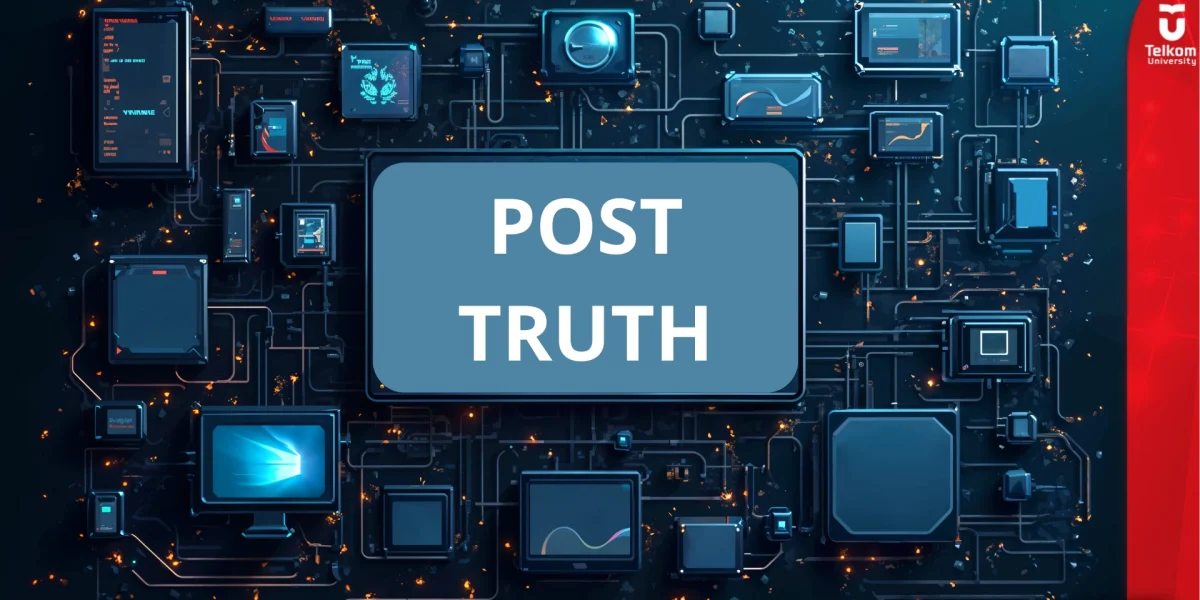Understanding the Post-truth Era and Its Impact on Digital Literacy

In a world increasingly filled with digital information, the term post-truth has become relevant to describe a social phenomenon where objective facts are often ignored and replaced by emotional beliefs or personal preferences. The term gained widespread attention when in 2016, Oxford Dictionaries named it Word of the Year. The post-truth phenomenon shows how public opinion is no longer formed by scientific facts or verified data, but is more influenced by emotions and subjective beliefs.
Characteristics and Roots of Post Truth as Digital Literacy

1. The Influence of Emotions and Cognitive Bias
In the post-truth era, objective facts are often pushed aside, while information that is more emotionally salient and reinforces existing beliefs is more easily accepted. This phenomenon is triggered by cognitive biases that make individuals tend to only accept information that is in line with their views. Social media, with algorithms that tailor content based on user preferences, reinforces this by creating echo chambers, where a person only sees viewpoints that reinforce their beliefs.
2. Proliferation of Fake News and Disinformation
One of the phenomena that strengthens the post-truth era is the rise of fake news. This inaccurate or intentionally misleading information is often created to trigger emotional reactions, spread panic, or pursue certain political goals. With so much information circulating, it is difficult for the public to sort out which information is true and which is just a hoax or disinformation. This becomes even more complex when the wrong information continues to spread on social media without adequate verification.
3. Information Polarization
The post-truth era is also marked by increasing societal polarization. People are increasingly separated into groups that only consume information that is in line with their own beliefs, avoiding information that is different or contradictory. As a result, the digital public space is fragmented and it is difficult to reach consensus on important issues.
The Impact of the Post Truth Era on Digital Literacy
1. Decreased Critical Thinking Skills
One of the direct impacts of the post-truth era on digital literacy is the decline in the ability to think critically. In a world where information is easily accessible and disseminated, many people tend to accept what they read without critically examining it. This can lead to accepting inaccurate or misleading information without doing in-depth fact-checking. Low digital literacy makes individuals more susceptible to misinformation, exacerbating existing disinformation.
2. The Need to Improve Digital Literacy
To face these challenges, digital literacy needs to be strengthened. Digital literacy is not only about the ability to use digital devices, but also includes the ability to evaluate and verify information. Good digital literacy means being able to distinguish between credible and uncredible sources of information, identify bias, and understand the context of the information consumed. This literacy also requires users to understand how algorithms work behind social media and search platforms, and their impact on what they see.
3. Challenges for Education and Media
The world of education and the media industry face major challenges in the post-truth era. On the one hand, educational institutions need to adapt by teaching digital literacy and critical thinking skills to students from an early age. Curricula need to be adjusted to teach how to assess sources of information, check facts, and understand the impact of spreading false information. On the other hand, the media has a big responsibility in maintaining the integrity of the information they disseminate. Quality journalism with strong verification of information must continue to be encouraged to counter the flow of fake news.
4. The Role of Social Media and Digital Platforms
Social media platforms also play a significant role in the post-truth era. The algorithms used by these platforms often amplify more popular or controversial content, rather than more truthful or verified content. This makes it easier for fake news or content that provokes emotions to go viral. As a result, there is a growing push for tech companies to develop tools that help users verify information and identify hoaxes.
Facing the Challenges of the Post-truth Era
1. Fact Verification as a Primary Need
To combat disinformation, fact-checking should be a top priority in information consumption. Individuals need to actively check the authenticity of the information they receive, especially on social media, before sharing it with others. Tools and services such as TurnBackHoax.id or FactCheck.org are very useful in helping people verify the veracity of information.
2. Development of Digital Literacy Awareness
Increasing digital literacy among the community must be a primary focus. This applies not only in schools, but also in the community, through community training and education programs. With better knowledge of how information is spread in the digital world, the community will be better prepared to face the challenges of the post-truth era.
3. Get Away from the Digital Echo Chamber
People need to get out of their digital “echo chambers” and seek information from a variety of different sources. Accessing multiple perspectives will help to understand issues more holistically and prevent the influence of excessive bias.
The post-truth era has changed the way we view and consume information, with a major impact on people’s digital literacy. The spread of misinformation and information polarization has made the importance of critical thinking and information evaluation skills even clearer. Improving digital literacy through education, responsible media, and information verification is key to combating this challenge. Only with better understanding and strong digital skills can we combat the negative effects of post-truth and ensure that people continue to have access to true and accurate information.


